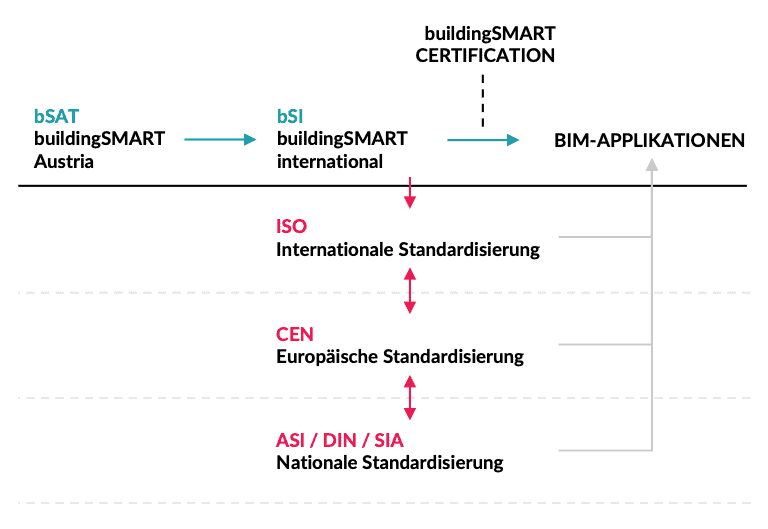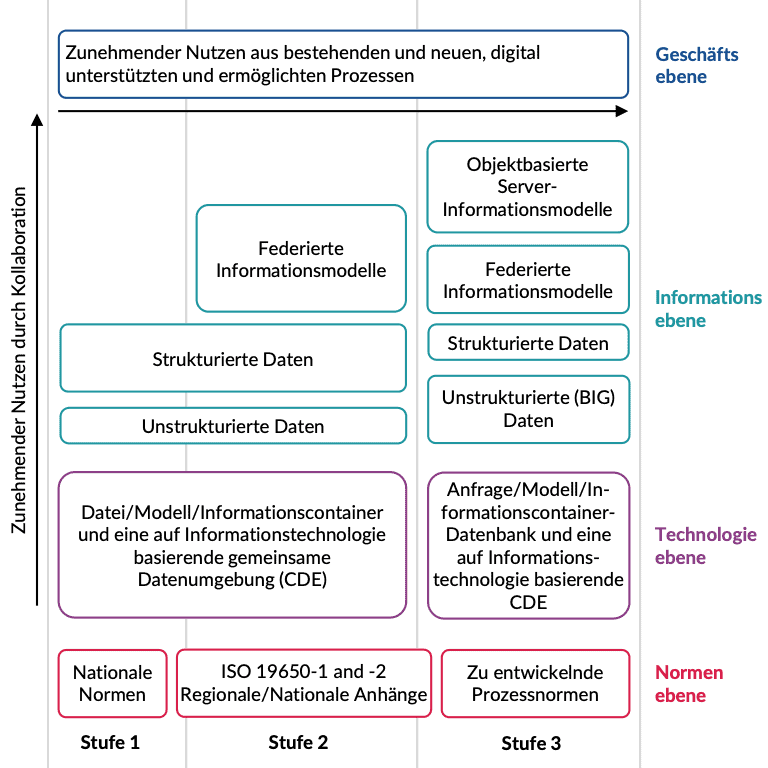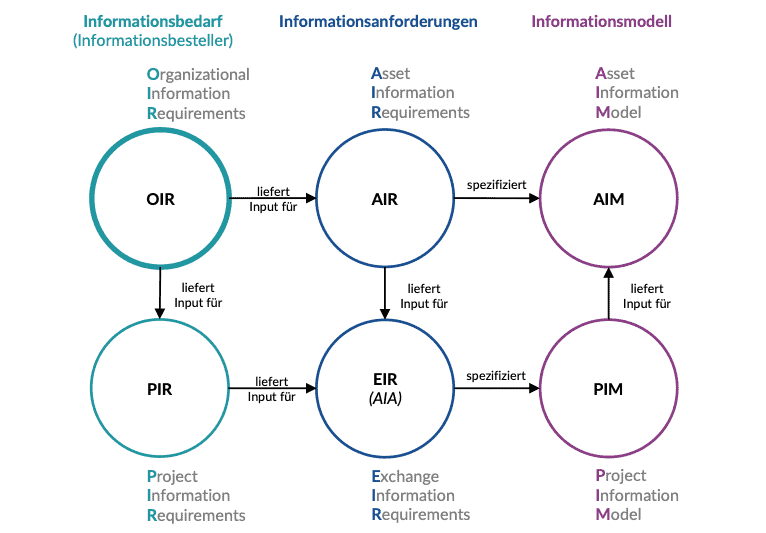Today, there are over 6500 different languages. The exchange of information within the same language(closed) is easier than between different languages(open). In order to exchange information between the individual languages without major loss of information, many countries have agreed on a standard – e.g. the language “English”. The openBIM method requires a manufacturer-neutral exchange of data. The implementation of the openBIM method therefore also requires clear and open standards so that there is as little loss of information as possible during exchange. As an independent association, bSI develops its own standards (e.g. IFC).

ISO 16739-1 – Industry Foundation Classes (IFC)
The object-oriented IFC specification first appeared as IFC1.0 in 1996. The IFC4 version was officially published in March 2013 as ISO 16739 and is being continuously developed (since 2018: ISO 16739-1). The current version is IFC4.3 TC1. This version includes new elements and localization options for civil engineering. ISO certification guarantees the long-term usability of the model data. The certification of a software does not apply to the entire IFC data structure, but to a specific Model View Definition (MVD).
ISO 12006-3 – Framework for object-oriented information (for bSDD)
In addition to the data structure, bSI is developing the international property server bSDD, which enables the international exchange of product information. The bSDD is based on ISO 12006-3, which defines the IFD. The IFD (International Framework for Dictionaries) is a framework for defining classification systems. The basic principle is that all concepts can have a name and a description (regardless of the language). However, only a unique identification code is relevant for identification and use. By attaching labels in several languages to the same concept, a multilingual dictionary is created.
ISO 19650 series – Information management with BIM
The title of the ISO 19650 series of standards is “Organization and digitization of information on construction works and engineering services, including construction information modelling-information management with BIM“. It consists of 6 parts, with part 6 still under development (as of January 2024). They provide specifications for terms, concepts and processes that define BIM services and their implementation. Collaborative cooperation using the principles of ISO 19650 by all project participants improves information management. Open data formats should always be used. This standard refers to the workflow of information creation in a project as the information provision cycle.
ISO 19650-1: Concepts and principles
The first part of the standard describes terms and principles for information management. In the appointment process, there is the appointing party and the appointed party. The former is usually the client or owner and receives the information from the lead information provider. The information provider is usually a delivery team, which can consist of the lead information provider and participating information providers – it can consist of one person up to complex, multi-layered task teams.
Clearly defining the roles, responsibilities, powers and scope of each task is important for effective information management. Responsibilities are regulated by means of aresponsibility matrix. According to ISO 19650-1, a responsibility matrix is a matrix that describes the proportionate responsibility of the various functions (roles) in the completion of tasks or information provision services. It therefore defines the information management functions (role and tasks), the project or asset information management tasks and the information provision services.
In addition to the responsibility matrix, information provision planning also includes the definition of a federation strategy and the structure schema for the information containers. According to ISO 19650-1, an information container is a named persistent collection of information that can be retrieved within a file, a system or an application hierarchy; this could be: Subdirectory, information file (incl. model, document, table, schedule). The term federation was taken directly from the English term federation . It means the composition of information models from separate (specialized) models (information containers). ISO 19650-1 requires that the information provision plan specifies
- how the information fulfills the requirements defined in the asset information requirements or the exchange information requirements,
- when the information will be provided (project phases, milestones, specific dates),
- how and what information is provided and by whom,
- how the information from different providers is coordinated and
- who receives the information.
In information management according to ISO 19650, this standard defines different maturity levels (stage/stage) with the respective development stages (see also Fig. 2.2). These maturity levels/development stages have an influence on different levels: Standards level, Technology level, Information level and Business level.
- Level 1: Combination of 2D CAD planning and 3D models as the standard for planning construction projects and, above all, the use of national standards
- Level 2: The consistent application of ISO 19650 (use of information management processes) and national and regional annexes as well as the use of federated information models (combination of several models)
- Stage 3: openBIM as the standard for planning construction projects

In addition, this standard defines the perspectives of information management. From the perspective of the asset owner , the purpose of the asset/project must be defined and maintained. Strategic decisions must be made. This includes a business plan, a strategic asset portfolio analysis, a life cycle cost analysis, etc. The true requirements of the users of the asset must be identified and ensured (structural solution offers required quality and capacity). The project description, an asset information model, a project information model, product documentation, etc. serve this purpose. The planning and organization of work, the mobilization of resources and the coordination and control of project/asset development are important for project implementation or asset management . This is supported by plans (e.g. BIM execution plans), organizational charts, function definitions, etc. The social and societal perspectiveincludes ensuring that the interests of the community are taken into account in the life cycle. This includes political guidelines, area plans, building permits, concessions, etc.
ISO 19650 is divided into two phases, each of which has a model. Thedelivery phase concerns the planning, construction and commissioning phase and uses the project information model (PIM). Theoperational phase concerns the period in which the building is used, operated and maintained and uses the asset information model (AIM). The asset information model always corresponds to the current status of the structure (i.e. it is constantly updated). Bothinformation models contain both geometric and alphanumeric information as well as additional information on the performance requirements during planning, the construction method and the operation of the structure (e.g. maintenance costs, maintenance dates) etc. by means of project documentation. According to ISO 19650, these information models therefore contain structured information containers (e.g. geometric models, schedules, databases) and unstructured information containers (e.g. documentation, video clips, audio recordings). The models have differentinformation requirements, which influence each other (see Fig. 2.3). The information requirements define what information should be created for what, when, how and for whom.

The Organizational Information Requirements (OIR) define the information requirements of the client in relation to its organizational objectives within the company. These arise, for example, from strategic business activities, strategic asset management, portfolio planning, regulatory tasks, etc. The OIR provide input for both the Asset Information Requirements (AIR) and the Project Information Requirements (PIR). The AIR take into account the business, commercial and technical aspects of information creation in relation to the operation of the asset. The PIRs relate to the requirements in the deployment phase of an asset. They are required in order to respond to the overarching strategic objectives in relation to a specific project. The client’s overarching project objectives therefore provide the basis for the project-related BIM objectives. Both the AIR and the PIR provide input for the Exchange Information Requirements (EIR). These relate to the business, commercial and technical aspects of information creation. The AIR and the PIR therefore determine the content, structure and methodology of the AIM and the PIM.
ISO 19650-2: Planning, construction and commissioning phase
This section is intended to support information purchasers (e.g. clients) in determining their information requirements during the planning and construction phase of an asset.
For this phase, this standard defines
- Task Information Delivery Plan (TIDP) as a plan of information containers and delivery dates for a specific task team,
- Master Information Delivery Plan (MIDP) as a plan that contains all relevant task-related information delivery plans, and
- Information delivery milestones as planned events for a predefined exchange of information.
ISO 19650-3: Operating phase of the assets
This part is intended to support information purchasers (e.g. clients) in determining their requirements for information during the operational phase of an asset, i.e. during asset management and facility management. The defined information management processes can be applied to trigger events, which may be foreseen (planned in advance) or unforeseen (unplanned).
ISO 19650-4: Information exchange
This part is dedicated to the explicit process and criteria of information exchange to ensure the benefits that result from collaborative and interoperable BIM and the choice of open schemas and data formats and conventions.
In this section, the new terms information provider, information recipient and information evaluator are introduced. These terms are particularly important in relation to a CDE and changing the status of information. An information assessor must check information before approving this information to the status “Shared” or later to the status “Published”. In doing so, they check the information for compliance with the CDE requirements for naming (and metadata), conformity, continuity, communication (no degradation or loss through transmission), consistency and completeness.
ISO 19650-5: Specification for safety aspects of BIM, digitized buildings and smart asset management
By self-definition, this part seeks to provide a framework to help organizations understand the key security gaps and the type of governance required to limit the resulting security risks to a level that is acceptable to all stakeholders andto reduce the risk of loss, misuse or modification of sensitive information. The aim is to create and maintain appropriate and proportionate security awareness and a corresponding security culture in organizations.
ISO 19650-6: Health and safety
This part is still in the decision-making phase as of January 2024. According to its own definition, this part describes concepts and principles to ensure that health and safety information is classified, shared and provided collaboratively and that the economic, environmental and social benefits are ensured.
Publication from Eichler, C.C., Schranz, Ch., Krischmann, T., Urban, H., Hopferwieser, M., Fischer, S.: BIMcertHandbuch- Grundlagenwissen openBIM. Issue 2024. Mironde-Verlag, Niederfrohna, 2024. DOI: 10.34726/5384
URL: https://repositum.tuwien.at/bitstream/20.500.12708/192612/3/Eichler-2024-BIMcert %20Handbuch%20basic-knowledge%20openBIM-vor.pdf
Status: 23.01.2024
